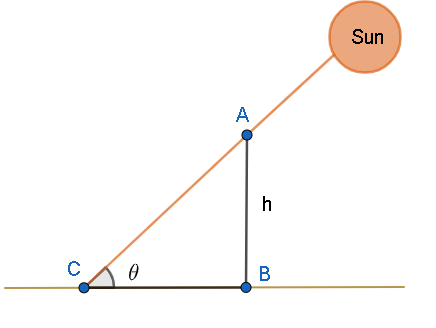
Shadow of a vertical pillar is equal to the height of the pillar then the angle of elevation of sun will be:
(a) $90{}^\circ $
(b) $60{}^\circ $
(c) $45{}^\circ $
(d) $30{}^\circ $
Answer
504.9k+ views
Hint: To find the angle of elevation of the sun, we have to draw a figure with the given data. We will then obtain a triangle. We have to use the formula $\tan \theta =\dfrac{\text{Opposite side}}{\text{Adjacent side}}$ to find the value of $\theta $ , that is, the angle of elevation of sun. According to the given condition, opposite and adjacent sides will be equal.
Complete step by step answer:
We are given that the shadow of a vertical pillar is equal to the height of the pillar. Let us draw a figure of this scenario.

From the figure, we can see that when the sun rays fall on the top of the pillar of height AB, a shadow of length BC is created. From the given condition, we can write
$\text{AB}=\text{BC}$
Let us assume the height of the pole to be h.
$\Rightarrow \text{AB}=\text{BC}=h...\left( i \right)$
Now, we have to find the angle of elevation of the sun, that is, $\theta $ .
We know that $\tan \theta =\dfrac{\text{Opposite side}}{\text{Adjacent side}}$ .
Here, the opposite side is AB and the adjacent side is BC.
$\Rightarrow \tan \theta =\dfrac{\text{AB}}{\text{BC}}$
Let us substitute the value of AB and BC from (i) in the above equation.
$\begin{align}
& \Rightarrow \tan \theta =\dfrac{h}{h} \\
& \Rightarrow \tan \theta =1 \\
\end{align}$
We know that $\tan 45{}^\circ =1$ . Let us substitute this value in the above equation.
\[\begin{align}
& \Rightarrow \tan \theta =\tan 45{}^\circ \\
& \Rightarrow \theta =45{}^\circ \\
\end{align}\]
Therefore, the angle of elevation of the sun is $45{}^\circ $ .
So, the correct answer is “Option c”.
Note: Students must understand the question clearly and then draw a figure with the given data. Students must know to find the trigonometric angles using a triangle. We can find $\sin \theta $ by taking the ratio of the opposite side to the hypotenuse. Similarly, we can find $\cos \theta $ by taking the ratio of the adjacent side to the hypotenuse. Students must know the sides of the triangle. Also, they must note that we can apply these trigonometric formulas only when the given triangle is a right-angled one.
Complete step by step answer:
We are given that the shadow of a vertical pillar is equal to the height of the pillar. Let us draw a figure of this scenario.

From the figure, we can see that when the sun rays fall on the top of the pillar of height AB, a shadow of length BC is created. From the given condition, we can write
$\text{AB}=\text{BC}$
Let us assume the height of the pole to be h.
$\Rightarrow \text{AB}=\text{BC}=h...\left( i \right)$
Now, we have to find the angle of elevation of the sun, that is, $\theta $ .
We know that $\tan \theta =\dfrac{\text{Opposite side}}{\text{Adjacent side}}$ .
Here, the opposite side is AB and the adjacent side is BC.
$\Rightarrow \tan \theta =\dfrac{\text{AB}}{\text{BC}}$
Let us substitute the value of AB and BC from (i) in the above equation.
$\begin{align}
& \Rightarrow \tan \theta =\dfrac{h}{h} \\
& \Rightarrow \tan \theta =1 \\
\end{align}$
We know that $\tan 45{}^\circ =1$ . Let us substitute this value in the above equation.
\[\begin{align}
& \Rightarrow \tan \theta =\tan 45{}^\circ \\
& \Rightarrow \theta =45{}^\circ \\
\end{align}\]
Therefore, the angle of elevation of the sun is $45{}^\circ $ .
So, the correct answer is “Option c”.
Note: Students must understand the question clearly and then draw a figure with the given data. Students must know to find the trigonometric angles using a triangle. We can find $\sin \theta $ by taking the ratio of the opposite side to the hypotenuse. Similarly, we can find $\cos \theta $ by taking the ratio of the adjacent side to the hypotenuse. Students must know the sides of the triangle. Also, they must note that we can apply these trigonometric formulas only when the given triangle is a right-angled one.
Recently Updated Pages
Two men on either side of the cliff 90m height observe class 10 maths CBSE

What happens to glucose which enters nephron along class 10 biology CBSE

Cutting of the Chinese melon means A The business and class 10 social science CBSE

Write a dialogue with at least ten utterances between class 10 english CBSE

Show an aquatic food chain using the following organisms class 10 biology CBSE

A circle is inscribed in an equilateral triangle and class 10 maths CBSE

Trending doubts
Why is there a time difference of about 5 hours between class 10 social science CBSE

Write a letter to the principal requesting him to grant class 10 english CBSE

What is the median of the first 10 natural numbers class 10 maths CBSE

The Equation xxx + 2 is Satisfied when x is Equal to Class 10 Maths

Which of the following does not have a fundamental class 10 physics CBSE

State and prove converse of BPT Basic Proportionality class 10 maths CBSE




